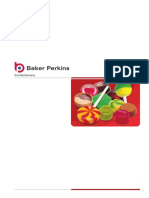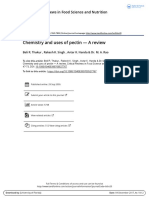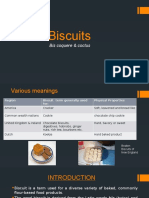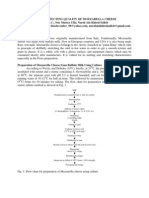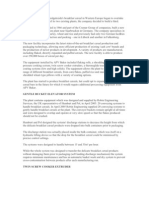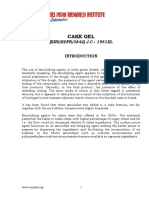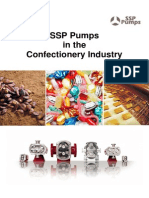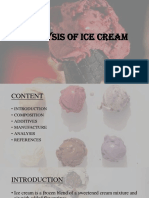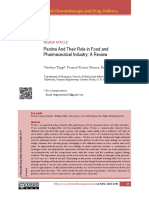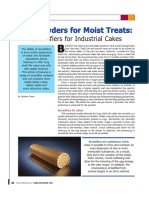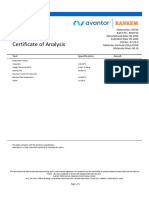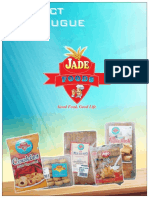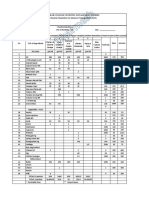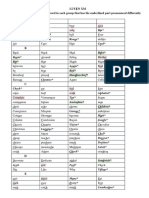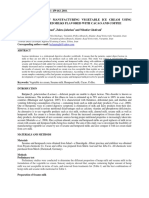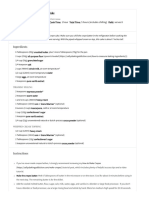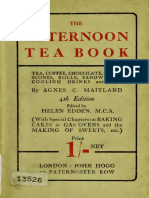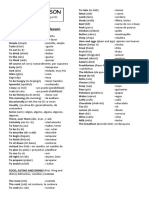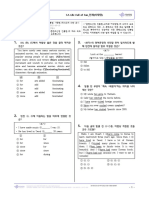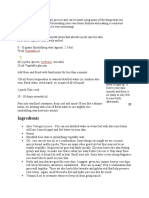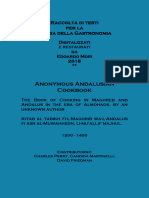Baking Update
Baking Update
Uploaded by
Achyut TripathiCopyright:
Available Formats
Baking Update
Baking Update
Uploaded by
Achyut TripathiCopyright
Available Formats
Share this document
Did you find this document useful?
Is this content inappropriate?
Copyright:
Available Formats
Baking Update
Baking Update
Uploaded by
Achyut TripathiCopyright:
Available Formats
LALLEMAND
VOLUME 2 / NUMBER 19
BAKING UPDA TE
Practical technology from Lallemand Inc., parent of American Yeast Sales, producers and distributors of Eagle yeast, fresh and instant.
AMERICAN YEAST SALES
Cookies and Biscuits
Structure Builders and Tenderizers
Ingredients used in baked goods such as cookies, biscuits, crackers, and cakes are sometimes categorized as structure builders or tenderizers. Structure builders are, in general, the ingredients that strongly interact to build the continuous structure in a product that keeps the product together and gives it its rmness. Tenderizers are ingredients that interrupt this structure, thus making the product more soft and tender. While the classication of ingredients into structure builders and tenderizers differs from one product to another, it can still be a useful concept when adjusting a formula to obtain certain product characteristics. Flour is a structure builder in most baked goods (cookies, cakes, crackers, and bread). Gluten protein develops during mixing to form a continuous structure in the dough so the baked product can become very hard and tough when specic volume of the product or its moisture content is low. This is undesirable for cookies, crackers, and biscuits, and, therefore, tenderizers are added that interrupt the continuous gluten structure or prevent the formation of such a continuous gluten structure. Shortening (oil), when used at high levels, is the main ingredient used as a tenderizer. It shortens the gluten structure by preventing proper hydration of the our particles, the rst step in the development of a continuous gluten structure. Proteases break down the continuous gluten protein and are used to improve tenderness of cookies and crackers. Sugar lowers water activity, and high levels prevent a quick hydration of gluten protein. High sugar levels in cookies will also prevent the starch from gelatinizing during baking so it cannot set up a continuous structure in the product. Therefore, sugar usually acts as a tenderizer. In sugarsnap cookies, however, sugar (sucrose)
Continued
Cookie and Biscuit Production
origin and means twice cooked. In earlier times some dough products were baked twice, once to set the structure of the product and again to further reduce the moisture content so the product acquired a long shelf life. This way travelers, soldiers, and sailors could use these storagestable products as their principal food source. Nowadays, only a few products are baked twice (for example, rusks, biscotti, croutons, and Melba toast), while most biscuits and cookies are baked only once. In Europe the word biscuit is used for low-moisture products that are made with high levels of sugar and shorteningproducts that are called cookies in the United States. In the U.S., biscuit refers to a unique American product that was introduced by eighteenth century colonists and has become especially popular in the South. The U.S. biscuit is a chemically leavened product with a moisture content similar to bread, but produced by a different process and with quite a different taste and texture. To avoid confusion, the U.S. terminology for biscuits and cookies will be used from here on.
COOKIES
HE WORD biscuit is of French
In general, cookies are made from soft wheat our, contain high levels of sugar and shortening, and have a low moisture content.
All cookies are produced from low-protein soft ours, using gentle mixing to produce a dough without developing the gluten protein. Industrially produced cookies can be categorized into three general types by the way the cookie dough is divided and placed on the band of a long tunnel oven. Rotary-mold cookies are produced from dough that is forced into the molds of a rotating drum. While the drum turns, the excess dough is scraped off, and the dough pieces with the imprint from the mold are extracted from the cavity and placed on the band of the tunnel oven for baking. The consistency of the cookie dough is critical for this type of operation and has to be carefully controlled. Rotary-mold cookie formulations contain intermediate levels of shortening and sugar, but low levels of water. These cookies do not expand much during baking, so the imprint from the mold remains visible after baking. Because of the low water content in the dough, less energy is required during baking. The low water content in the dough and the high output of the line make rotary-type cookies the most economical to produce. Cutting-machine cookies are produced from dough with less sugar, less shortening, and more water than rotary-mold cookies. Therefore, some gluten is developed during mixing that holds the dough together
Continued
COOKIE FORMULAS
ROTARY MOLD Flour Sugar Shortening Water Baking powder Salt Eggs Flavoring Milk powder 100% 2050% 2540% 10% (varies) 5% (varies) 1.5% 05% (varies) varies 02% (varies) CUTTING MACHINE 100% 25% 25% 1020% (varies) 5% (varies) 1.5% 05% (varies) varies 02% (varies) WIRE-CUT AND DEPOSIT 100% 3075% (varies) 3060% (varies) 1020% (varies) 5% (varies) 1.5% 7.510% varies 02% (varies)
Cookies and Biscuits
(Continued)
TYPICAL BISCUIT FORMULA AND PROCESS
FORMULA Flour Shortening Sugar Baking powder Salt (Butter)milk Whole eggs 100% 20 (1040)% 4 (015)% 5 (46)% 2 (13)% 65 (6070)% 0% (varies) Resting Sheeting Cutting Baking Mixing PROCESS Short time and dough temperature of 6065F 15 minutes (varies)
38
during sheeting, so the cookies can be cut out, with the scrap dough returning to the mixer. The partial development of gluten also prevents the cookie from spreading during baking and tends to make the cookie hard. Wire-cut cookies are produced by extruding soft dough containing high levels of sugar, shortening, and eggs through an orice and cutting disk-shaped cookies by a wire. Wire-cut cookies spread and increase in size during baking. When levels of sugar and water of a wire-cut cookie formula are increased further, the cookie dough becomes viscous so the dough can be deposited directly on the band of the oven so it will spread out before and during baking.
BISCUITS
/ inch (varies)
231/4 inch 1015 minutes at 475F
pH during dough mixing will be high enough to prevent rapid gluten development. Mixing times should be adjusted to optimize sheeting properties of the dough, not to develop the gluten protein. Use shortening at relatively high levels. Shortening will give the biscuit its desirable tender eating quality. Any type of hydrogenated vegetable shortening can be used, while oil is not recommended because it makes the dough sticky. Too high a level of shortening (greater than 30 percent) should be avoided because it reduces the volume of the biscuit and prevents proper setting of the biscuit structure during baking. Control dough temperature. This is important because dough temperature will affect sheeting properties, especially when high levels of shortening are used. Use baking powder to optimize biscuit volume. Usually baking powders with low levels of MCP work best, especially when buttermilk is used containing lactic acid as a fast-acting leavening acid. Baking powders used for biscuits usually contain SALP and/or SAPP to produce carbon dioxide gas mainly during baking. Optimal loaf volume will result in a less dense biscuit that is soft and tender.
Structure Builders and Tenderizers (Continued)
crystallization in the baked product causes the cookie to become hard and brittle over time. Baking powder or yeast is used in many baked goods to increase specic volume, thus making a product less rm and dense. Baking powder also gives the dough an alkaline pH that interferes with a quick hydration and development of a continuous gluten structure. Water is required to develop a continuous gluten structure during mixing and a continuous starch structure during baking, but it can also act as a plasticizer/tenderizer in the nal baked product. For this reason, cookies become softer when stored outside the package in a humid environment.
The U.S. biscuit uses a simple process to produce a dough that is sheeted, cut into disk-shaped pieces, placed on a sheet, and baked in an oven. Biscuit dough is quite different from bread dough. Low-protein soft wheat ours are preferred and chemical leavening is used for gas production, while a mixing procedure is used to optimize dough machinability and sheeting properties. This gives the nished product a much lower specic volume, thicker cell walls, and coarser grain. The taste is strongly inuenced by the baking soda and the leavening acids of the baking powder. High-quality biscuits are preferably consumed when fresh and have a soft and tender bite. Here are some recommendations for optimal biscuit quality: Use a soft, low-protein our and limit gluten development. Gluten, when developed during mixing, becomes the continuous structure in the biscuit dough, making the bite rmer. The use of baking powder (soda) ensures that the
LALLEMAND
BAKING UPDATE
Lallemand Baking Update is produced by Lallemand Inc. to provide bakers with a source of practical technology for solving problems. If you would like to be on our mailing list to receive future copies, or if you have questions or comments, please contact us at: LALLEMAND Inc. 1620 Prfontaine Montral, QC H1W 2N8 CANADA tel: (800) 840-4047 (514) 522-2133 fax: (514) 255-6861
To the best of our knowledge, the information in Lallemand Baking Update is true and accurate. However, any recommendations or suggestions are made without warranty or guarantee. 2000 Lallemand Inc.
Lallemand Baking Ingredients
ALLEMAND Inc. is a leading producer of yeast, baking powders, and dough conditioners and supplies a complete assortment of baking ingredients distributed through Lallemand Distribution and American Yeast Sales. All Lallemand products are backed with problem-solving technical support from experienced baking technicians. For producers of cookies and biscuits, the following products are of interest: Eagle Double Acting Baking Powder and Eagle Bakers Cream are supplied in ten-pound pails and fty-pound bags.
Special baking powders tailored to specic requirements of the particular product or bakery can be provided. LBI 2130 and LBI 2133 are avor products based on inactive yeast that are used for taste and avor enhancement in baked goods such as biscuits and cookies. Fermaid is a range of enzyme-based dough conditioners for improving the product characteristics of baked goods including bread, cakes, crackers, cookies, and biscuits.
LALLEMAND products are distributed by its subsidiaries, AMERICAN YEAST SALES and LALLEMAND DISTRIBUTION.
AMERICAN YEAST SALES
LALLEMAND
Lallemand Baking Update Volume 2/Number 19
You might also like
- Spreadable Cheese Quality White PaperDocument20 pagesSpreadable Cheese Quality White PaperAndreina Stefani100% (1)
- Manual Oster TSSTTVCAO1Document16 pagesManual Oster TSSTTVCAO1Angelica de jesusNo ratings yet
- Confectionery Sector NewsletterDocument16 pagesConfectionery Sector NewsletterDivya PrakashNo ratings yet
- Troubleshooting Milk Flavor Problems - Dairy Cattle Nutrition - Penn State ExtensionDocument7 pagesTroubleshooting Milk Flavor Problems - Dairy Cattle Nutrition - Penn State ExtensionCostaEdvaldoNo ratings yet
- Mead Making DocumentDocument9 pagesMead Making DocumentMauricio José TorresNo ratings yet
- Ember És Társadalom EDocument14 pagesEmber És Társadalom EAnita HajduNo ratings yet
- 5-Q5b-Training Handbook - Whey Every AspectDocument288 pages5-Q5b-Training Handbook - Whey Every AspectMinh HiếuNo ratings yet
- Baking Update - Bun and Roll ProductionsDocument2 pagesBaking Update - Bun and Roll ProductionsAgnesya AdifiliaNo ratings yet
- Brochure Quality Confectionery - Eng - May 11Document8 pagesBrochure Quality Confectionery - Eng - May 11bikal_sthNo ratings yet
- Natural Ingredients-Based Gummy Bear Composition Designed According To Texture Analysis and Sensory Evaluation in VivoDocument16 pagesNatural Ingredients-Based Gummy Bear Composition Designed According To Texture Analysis and Sensory Evaluation in VivoMargarita LópezNo ratings yet
- Advances in Modifying and Understanding Whey Protein FunctionalityDocument9 pagesAdvances in Modifying and Understanding Whey Protein FunctionalityAnis RanisNo ratings yet
- Pasta-Filata CheesesDocument28 pagesPasta-Filata CheesesLissNo ratings yet
- Filling Cream Pada Biskut, WaferDocument4 pagesFilling Cream Pada Biskut, WaferFadhilla SetyaNo ratings yet
- Enzymes in BakeryDocument23 pagesEnzymes in Bakeryaditi_nangia_1No ratings yet
- Food Processing Technology I: Defry Lesmana, M.K.M. Aprilia Fitriani, M.SCDocument29 pagesFood Processing Technology I: Defry Lesmana, M.K.M. Aprilia Fitriani, M.SCAprilia Oanima100% (1)
- Evaluation of Functional Properties and Microstructure of Mozzarella Cheese, and Their CorrelationDocument145 pagesEvaluation of Functional Properties and Microstructure of Mozzarella Cheese, and Their CorrelationKhaja LashkariNo ratings yet
- Product Data Sheet: Novamyl® 1500 MGDocument2 pagesProduct Data Sheet: Novamyl® 1500 MGمحمد صبحيNo ratings yet
- Diagnosis-Bloom Chocolate Forensics 101: Thalia HohenthalDocument45 pagesDiagnosis-Bloom Chocolate Forensics 101: Thalia HohenthalJulio KinenNo ratings yet
- Production of Instant Soymilk Powders by Ultra Ltration, SprayDocument12 pagesProduction of Instant Soymilk Powders by Ultra Ltration, SprayNguyễn Quang100% (2)
- Toffee Food TechnologyDocument19 pagesToffee Food TechnologyNgọc DungNo ratings yet
- HUMECTANTDocument12 pagesHUMECTANTSakhtar_ft100% (2)
- Influence of Various Hydrocolloids On Cottage Cheese Cream DressingDocument10 pagesInfluence of Various Hydrocolloids On Cottage Cheese Cream DressingLorenzo LeurinoNo ratings yet
- 00.protein Modification During Ingredient PreparationDocument41 pages00.protein Modification During Ingredient PreparationKiefer YuNo ratings yet
- Chemistry and Uses of Pectin - A Review: Critical Reviews in Food Science and NutritionDocument28 pagesChemistry and Uses of Pectin - A Review: Critical Reviews in Food Science and NutritionChí Linh TrầnNo ratings yet
- Alphamalt A7010 - PDS PDFDocument1 pageAlphamalt A7010 - PDS PDFEdwar André PgalNo ratings yet
- Pharmaceutical, Food and Non-Food Applications of Modified Starches: A Critical ReviewDocument8 pagesPharmaceutical, Food and Non-Food Applications of Modified Starches: A Critical ReviewAkhilesh V SinghNo ratings yet
- Functionlsity Starch in Snak Food1-2Document21 pagesFunctionlsity Starch in Snak Food1-2Adinda LarasatiNo ratings yet
- Biscuit Baking and Industries in IndiaDocument27 pagesBiscuit Baking and Industries in IndiaSam BoykaNo ratings yet
- Kathrine M. Putong August 8, 2015 BAPP04: Different Types of Ganache Basic GanacheDocument6 pagesKathrine M. Putong August 8, 2015 BAPP04: Different Types of Ganache Basic GanacheattycertfiedpublicaccountantNo ratings yet
- Advanced Dairy Science and TechnologyFrom EverandAdvanced Dairy Science and TechnologyTrevor BritzNo ratings yet
- Frozen ConeDocument8 pagesFrozen ConesorrinalorNo ratings yet
- Factor Affecting Quality of Mozzarella CheeseDocument5 pagesFactor Affecting Quality of Mozzarella CheeseWei Ching TayNo ratings yet
- Latest Technology in Cereals ProductionDocument5 pagesLatest Technology in Cereals ProductionNadherah MohamadNo ratings yet
- Enzymes in BakeryDocument9 pagesEnzymes in BakeryFatima ZahraNo ratings yet
- Susu SKM Dan EvaporatedDocument10 pagesSusu SKM Dan EvaporatedVitriMurzzeen100% (1)
- FINAL Lecture 1 - ConfectioneryDocument40 pagesFINAL Lecture 1 - ConfectioneryHANISYA BINTI ABDUL RAHMAN BN21110097No ratings yet
- Fulltext 12088 PDFDocument83 pagesFulltext 12088 PDFkharajurgNo ratings yet
- Nutela WikiDocument3 pagesNutela WikinecitacNo ratings yet
- Anchor Yeast Enzymes SolutionsDocument1 pageAnchor Yeast Enzymes SolutionsfrankNo ratings yet
- 010-Particle Size Analysis of Cocoa PowdersDocument3 pages010-Particle Size Analysis of Cocoa PowdersAlvian Maulana SNo ratings yet
- The Journey From Cacao Pod To ChocolateDocument9 pagesThe Journey From Cacao Pod To Chocolateronalit malintadNo ratings yet
- Project Report On Cake GelDocument5 pagesProject Report On Cake GelEIRI Board of Consultants and PublishersNo ratings yet
- Processing of Cereal GrainsDocument43 pagesProcessing of Cereal GrainsSagar ShahNo ratings yet
- Asia Food JournalDocument40 pagesAsia Food JournalYohan GunawanNo ratings yet
- AWT Pectin Amid CS 005Document8 pagesAWT Pectin Amid CS 005Dayana AriasNo ratings yet
- Innovative Uses of Milk Protein Concentrates (MPCS) in Product DevelopmentDocument22 pagesInnovative Uses of Milk Protein Concentrates (MPCS) in Product DevelopmentAli AkhtarNo ratings yet
- AWT Pectin Classic As 511Document3 pagesAWT Pectin Classic As 511Dayana AriasNo ratings yet
- Comparative Study of Deteriorative Changes in The Ageing of Milk PowderDocument8 pagesComparative Study of Deteriorative Changes in The Ageing of Milk PowderRayito HernándezNo ratings yet
- Milk ChocolateDocument6 pagesMilk ChocolateMy DiễmNo ratings yet
- SSP Pumps in The Confectionery Industry PDFDocument29 pagesSSP Pumps in The Confectionery Industry PDFfatamorgganaNo ratings yet
- DSM Enzymes For Biscuits Crackers WafersDocument19 pagesDSM Enzymes For Biscuits Crackers WafersRoxana Larisa Olteanu100% (1)
- 8 Bakey TechnologyDocument103 pages8 Bakey TechnologyPawan CoomarNo ratings yet
- Dairy Whitener: Rekha S. SinghalDocument13 pagesDairy Whitener: Rekha S. SinghalAbbas SaqibNo ratings yet
- Leaflet - Milk FermentationDocument3 pagesLeaflet - Milk FermentationNoor SultanNo ratings yet
- Analysis of IcecreamDocument32 pagesAnalysis of IcecreamDinesh SubramanianNo ratings yet
- ParleDocument56 pagesParlenamrocks0% (2)
- Pectins and Their Role in FoodDocument14 pagesPectins and Their Role in FoodKAKAW100% (1)
- Whey - A By-Product of The Dairy IndustryDocument31 pagesWhey - A By-Product of The Dairy IndustryOsman AitaNo ratings yet
- Emulsifiers For CakesDocument3 pagesEmulsifiers For Cakescklcat1437100% (1)
- Food Regulations On Confectionery ProductsDocument25 pagesFood Regulations On Confectionery ProductsDivya PrakashNo ratings yet
- Experiments in Tempering ChocolateDocument7 pagesExperiments in Tempering Chocolateklruppe3950No ratings yet
- Water Activity in Foods: Fundamentals and ApplicationsFrom EverandWater Activity in Foods: Fundamentals and ApplicationsRating: 5 out of 5 stars5/5 (1)
- Confectionery and Chocolate Engineering: Principles and ApplicationsFrom EverandConfectionery and Chocolate Engineering: Principles and ApplicationsNo ratings yet
- Coa IpaDocument1 pageCoa IpaAchyut TripathiNo ratings yet
- Jade BakeryDocument7 pagesJade BakeryAchyut TripathiNo ratings yet
- Bakery Unit All Products Except BreadDocument9 pagesBakery Unit All Products Except BreadAchyut TripathiNo ratings yet
- Bread Plant MachineryDocument4 pagesBread Plant MachineryAchyut TripathiNo ratings yet
- S.No. Date Variety S1 S2 S3 S4 S5 S6 S7Document6 pagesS.No. Date Variety S1 S2 S3 S4 S5 S6 S7Achyut TripathiNo ratings yet
- Sync2 Specific Competences Tests Speaking EOT3Document3 pagesSync2 Specific Competences Tests Speaking EOT3mfrancodlrubia100% (2)
- Rumania Ayu Pratiwi - LK 1Document8 pagesRumania Ayu Pratiwi - LK 1RUMANIA AYU PRATIWINo ratings yet
- Portugal Cuisine 1Document11 pagesPortugal Cuisine 1Hershey BantosaNo ratings yet
- Sugar Daddy ChurrosDocument6 pagesSugar Daddy Churrosrizaldorodriguez510No ratings yet
- 1 - Basic Concepts in Bread and Pastry ProductionDocument66 pages1 - Basic Concepts in Bread and Pastry ProductionRAYMART SARBODA100% (1)
- Keep On Eating Pizza, Sandwiches, Candy and Pastry: Vegan Alternatives For SnackingDocument3 pagesKeep On Eating Pizza, Sandwiches, Candy and Pastry: Vegan Alternatives For SnackingCruise LooNo ratings yet
- 6th Semester Menu No 1 .PDF 2022Document3 pages6th Semester Menu No 1 .PDF 2022Amaan ShaikhNo ratings yet
- Vanilla-Bean Sablé Cookies - Recipe - FineCookingDocument3 pagesVanilla-Bean Sablé Cookies - Recipe - FineCookingHelen Van KampenNo ratings yet
- Father: - Mother: - SisterDocument4 pagesFather: - Mother: - SisterChristine CabiasaNo ratings yet
- Sunfeast Segmentation, Targeting & PositioningDocument5 pagesSunfeast Segmentation, Targeting & PositioningApoorva Pattnaik100% (2)
- Luyen Am Tieng AnhDocument7 pagesLuyen Am Tieng Anhnhien.lethiNo ratings yet
- The Feasibility of Manufacturing Vegetable Ice Cream Using Sesame and Hempseed Milks Flavored With Cacao and Coffee PDFDocument5 pagesThe Feasibility of Manufacturing Vegetable Ice Cream Using Sesame and Hempseed Milks Flavored With Cacao and Coffee PDFGuevarra AngeloNo ratings yet
- Latihan Inggris 3Document2 pagesLatihan Inggris 3mariskapradani2No ratings yet
- Tiramisu Crepe Cake Recipe - Sally's Baking AddictionDocument3 pagesTiramisu Crepe Cake Recipe - Sally's Baking AddictionDayNo ratings yet
- Exotic Fruits and VegetablesDocument14 pagesExotic Fruits and VegetablesAndreea Corina IarcaNo ratings yet
- Lesson 1 - 4Document2 pagesLesson 1 - 4Aeiza CasquejoNo ratings yet
- Cook Yourself Thin RecipesDocument80 pagesCook Yourself Thin Recipesnellyestelar100% (4)
- Solar Oven Plans in PDFDocument10 pagesSolar Oven Plans in PDFmamodbasher33% (3)
- Tea BookDocument148 pagesTea BookAlicia de los santosNo ratings yet
- Sticky Date Tart 1Document5 pagesSticky Date Tart 1nadine marchand100% (1)
- 2 Second Lesson: New Vocabulary For This LessonDocument1 page2 Second Lesson: New Vocabulary For This LessonAlessandroNo ratings yet
- My Personal JournalDocument4 pagesMy Personal JournalMary GarciaNo ratings yet
- ( ) 2022 7.a Life Full of Fun - ( ) 2-2 (20 ) (Q)Document6 pages( ) 2022 7.a Life Full of Fun - ( ) 2-2 (20 ) (Q)stellame77No ratings yet
- Revision de Proyecto PDFDocument5 pagesRevision de Proyecto PDFVilcarana Jeferson R.No ratings yet
- Vocabulaire - IGCSEDocument53 pagesVocabulaire - IGCSEMohamedNo ratings yet
- LotionDocument5 pagesLotionCamille ValerioNo ratings yet
- Andalusian CookbookDocument228 pagesAndalusian CookbookТата СдвижковаNo ratings yet








